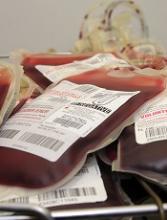Early blood transfusion is associated with improved survival among people with severe trauma sustained during combat, according to research published in JAMA.
Researchers studied medically evacuated US military personnel fighting in Afghanistan and found that patients who received blood products prior to hospitalization or within 15 minutes of medical evacuation were more likely to be alive at 24 hours and 30 days, when compared to patients who had delayed transfusions or did not receive transfusions.
Stacy A. Shackelford, MD, of Ft. Sam Houston in San Antonio, Texas, and her colleagues conducted this study to examine the association of prehospital transfusion and time to initial transfusion with injury survival.
The study included US military combat casualties in Afghanistan between April 1, 2012, and August 7, 2015. Eligible patients were rescued alive by medical evacuation from the point of injury with either:
- A traumatic limb amputation at or above the knee or elbow
- Shock, defined as a systolic blood pressure of less than 90 mm Hg or a heart rate greater than 120 beats per minute.
The study included 502, mostly male (98%), patients with a median age of 25 (range, 22 to 29). There were 55 patients who received prehospital transfusions (of red blood cells and/or plasma) and 447 who did not.
The rate of death within 24 hours of medical evacuation was 5% (3/55) among prehospital transfusion recipients and 19% (85/447) among nonrecipients (P=0.01). The rate of death by day 30 was 11% (6/55) and 23% (102/447), respectively (P=0.04).
The researchers also matched nonrecipients and recipients of prehospital transfusion by mechanism of injury, prehospital shock, severity of limb amputation, head injury, and torso hemorrhage. And the team adjusted their analyses for patient age, injury year, transport team, tourniquet use, and time to medical evacuation.
There were 386 matched patients with complete covariate data. Among these patients, the association of survival with prehospital transfusion remained significant at 24 hours and 30 days.
At 24 hours, the adjusted hazard ratio (aHR) for mortality was 0.26 (P=0.02). There were 3 deaths among the 54 prehospital transfusion recipients and 67 deaths among the 332 matched nonrecipients.
At 30 days, the aHR was 0.39 (P=0.03). There were 6 deaths among the 54 prehospital transfusion recipients and 76 deaths among the 332 matched nonrecipients.
The researchers also found that shorter time to initial transfusion, whether it occurred prior to or during hospitalization, was associated with reduced 24-hour mortality.
Transfusions occurring within 15 minutes of medical evacuation (a median of 36 minutes after injury) were associated with reduced mortality at 24 hours.
The aHR was 0.17 (P=0.02). There were 2 deaths among the 62 patients who received a transfusion within 15 minutes of medical evacuation and 68 deaths among the 324 patients who received delayed transfusions or did not receive transfusions.
When the researchers eliminated patients who did not receive transfusions, the aHR was 0.23 (P=0.04). There were 47 deaths among the 303 patients who received delayed transfusions (compared to 2 deaths among the 62 patients who received a transfusion within 15 minutes of medical evacuation).


